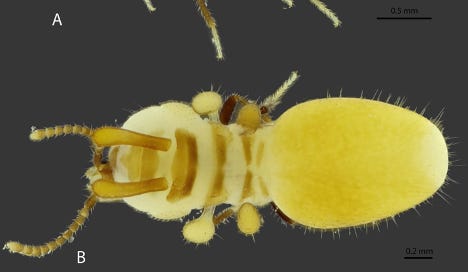The most fertile imaginations in Hollywood cannot compete with the improbable morphological creations found among earth’s diverse species. Weird by anyone’s standards are certain rove beetles found living among termites. Their abdomen is grotesquely enlarged and membranous, but it does not stop there. Such disproportionately large abdomens are found in quite a few insect lineages, a condition known as physogastrism. Queen termites, for example, have an abdomen so enlarged that they look like a bloated maggot sitting atop a tiny insect thorax and head.
Figure 1 from Zilberman and Pires-Silva (2023): Austrospirachtha carrijoi (A) lateral view; (B) dorsal view. Zootaxa 5336:424-432. Photo: by permission of Dr. Bruno Zilberman.
A recently described staphylinid beetle is a reminder not only of how weird physogastry can be when carried to extemes, but just how wondrous mimicry can be. The tribe Corotocini is a specially species-rich group of beetles living with termites. While there are defining details of mouthparts and antennae, it is the incredible physogastry among these beetles that makes the first and deepest impression.
The new species, Austrospirachtha carrijoi, KAR-E-YO=I less than two and one-half millimeters in length, was discovered in a small, eroded mound nest in the Northern Territory of Australia, along with both Australitermes and Nasutitermes termites. It is only the second known species of a genus which was discovered in the 1970s. It is described in exquisite detail by Zilberman and Pires-Silva in their paper in Zootaxa.
In forms like this one, not only is the abdomen swollen to ridiculous proportions, it is recurved forward overshadowing the thorax and head and — even more — it has weird sausage- or finger-like projections reminiscent of stubby legs. The physogastric abdomen in related beetles has been shown to produce the same cuticular hydrocarbons as host termites, helping them remain undetected as invaders in the nest by scent or taste — a case of chemical mimicry. And similar sausage-shaped appendages have been observed to be licked by termites, implying that they may be a site of such exudates. But viewed from above, Kistner and others have been struck by the obvious: this bloated belly, with strategically located constrictions and appendages amazingly looks like a termite!
Kistner predicted that the exact shape of the abdomen in different species would mirror the shape of the termite species with which they live. He was later shown, by Sands and Lamb, to be both correct and mistaken. Mistaken, because the shape of workers did not precisely match that of the beetle abdomen as predicted; correct, because the shape did closely resemble that of second-instar termite nymphs!
For staphylinid inquilines that lack these bizarre appendages and shapes, chemical-based mimicry still seems a good explanation of their strategy to be accepted by host termites. For species like this new one, it has been suggested that the elaborate abdominal shape may be a case of tactile mimicry, conforming to the expected body form of nest mates when explored by the antennae of curious termites. Some have also speculated that the sausage-shaped appendages could be sacrificial, like the tail of lizards, making an easy target for an attacking termite, and giving the beetle a chance to escape.
While additional natural history studies are needed to fully understand the function or functions of this weirdly-shaped physogastric abdomen, I am awed by the new species and others with similarly weird shapes for a much simpler reason. They are simply and shockingly awesome. No one can look at this beetle and at its host termites and not be impressed by the astonishing, almost unbelievable degree of mimicry. Mutations, combined with strong selection pressures, like surviving in the nest of a social insect, can result in all kinds of innovations—including some that go down an especially weird path.
Acknowledgment
I thank Dr. Bruno Zilberman for a copy of his paper and permission to reproduce the photographs of the new species.
References
Kistner, D. H. 1968. Revision of the African species of the termitophilous tribe Corotocini (Coleoptera: Staphylinidae). I. A new genus and species from Ovamboland and its zoogeographic significance. Journal of the New York Entomological Society 76: 213-221.
Sands, W.A. and R.W. Lamb. 1975. The systematic position of Kaudernitermes gen. n. (Isoptera: Termitidae: Nasutitermitinae) and its relevance to host relationships of termitophilous staphylinid beetles. Journal of Entomology (B) 44: 189-200.
Taylor, C. 2012. The Corotocini in their Gut-Swollen Glory. Catalogue of Organisms: An Inordinate Fondness for Systematics. 17 April.
Zilberman, B. and C.M. Pires-Silva. 2023. A new species and morphological notes on the remarkable termitophilous genus Austrospirachtha Watson from Australia (Coleoptera: Staphylinidae: Aleocharinae). Zootaxa 5336: 424-432.





Safety in numbers. I like it.
I wonder if the authors considered the possibility that the mimicry might be directed not to the host termites but to their predators. "Always hide among a lot of the same things." After all, the termites do not use vision and even if they did, would never view the mimic from above.